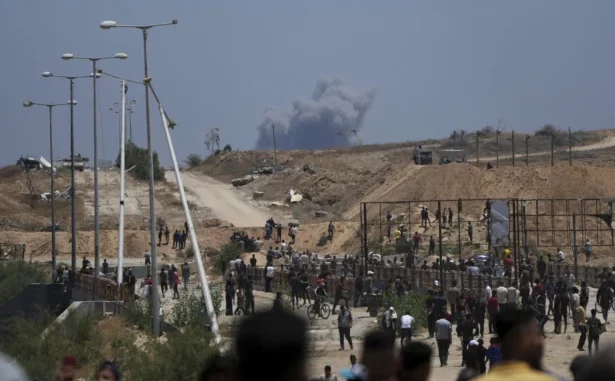
Smoke rises following an Israeli bombardment in Gaza, as seen from a humanitarian aid distribution center, in Khan Younis, Gaza Strip, on May 29, 2025. Abdel Kareem Hana/AP
| Published June 4, 2025
Israel Defense Forces spokesman Effie Defrin said Hamas terrorists ‘have been seen firing at civilians on their way to collect humanitarian assistance.’
In response to allegations that Israeli forces fired upon civilians at a humanitarian aid distribution site in Gaza, the Israel Defense Forces (IDF) have categorically denied involvement and released surveillance footage to support their claims. IDF spokesperson Brig. Gen. Effie Defrin stated, “Hamas spreads false information, which is unfortunately echoed by parts of the international media without any verification.” He emphasized that reports suggesting the IDF targeted civilians near the aid site operated by the U.S.-backed Gaza Humanitarian Foundation (GHF) are “completely false” and serve to amplify Hamas’s propaganda.
The IDF’s released footage purportedly shows masked individuals, identified as Hamas operatives, firing upon civilians attempting to collect humanitarian aid in Khan Younis. This video evidence is presented as part of Israel’s effort to refute claims made by Gaza’s Health Ministry, which reported that Israeli troops were responsible for the deaths and injuries of civilians at the aid site. The IDF maintains that its forces did not fire upon civilians and that any such reports are misinformation propagated by Hamas .
The situation underscores the complexities of information dissemination in conflict zones, where competing narratives and propaganda can obscure the realities on the ground. While the IDF provides video evidence to support its position, independent verification by third-party organizations is crucial to ascertain the facts surrounding such incidents. The international community continues to call for transparent investigations to ensure accountability and the protection of civilians amidst ongoing hostilities.
Palestinians carry boxes and bags containing food and humanitarian aid packages delivered by the Gaza Humanitarian Foundation, a U.S.-backed organization approved by Israel, in Khan Younis, southern Gaza Strip, on Thursday, May 29, 2025.
The implications of this incident center on national sovereignty, media accountability, and the global fight against terrorism:
1. Support for Israel’s Right to Defend Itself
Conservatives often view Israel as a key democratic ally in the Middle East. The IDF’s release of video evidence supports the argument that Israel is acting with restraint and facing an enemy—Hamas—that routinely lies and hides behind civilians.
2. Media Bias and Recklessness
This case reinforces long-standing conservative concerns about the mainstream media echoing anti-Israel narratives without proper fact-checking. It highlights the need for more skepticism of unverified claims and a call for media accountability during wartime.
3. Terror Groups Exploiting Humanitarian Channels
The incident strengthens the view that terrorist organizations like Hamas exploit humanitarian crises to demonize their enemies and manipulate global opinion. This supports a more cautious or conditional approach to aid distribution in conflict zones.
4. Importance of Strategic Communication
Conservatives may see Israel’s swift release of surveillance footage as a smart example of real-time strategic communication, something the U.S. and its allies should replicate when countering disinformation from hostile actors.
5. Call for Stronger Western Alignment with Israel
The backlash against Israel over unverified claims could be used to argue that the U.S. and its allies need to stand more firmly with Israel, rather than wavering under international pressure or social media outrage fueled by propaganda.
Overall Takeaway:
The incident near the Gaza aid site reflects a broader battle for truth in modern warfare, where controlling the narrative can be as impactful as controlling territory. Israel’s denial, supported by video evidence, and its accusation against Hamas of spreading false claims underscores how disinformation and propaganda complicate public understanding and international response.
In such high-stakes conflicts, independent verification and media integrity become essential. Without them, humanitarian crises risk being manipulated for political ends, and civilian suffering becomes harder to document—and harder to stop.
SOURCES: NTD – Israel Says Hamas Spreading ‘False Information’ About Gaza Shootings
THE TIMES OF INDIA – With ‘video proof’, Israel denies shooting at civilians collecting aid in Gaza, says ‘Hamas doing everything’
THE NEW YORK POST – Washington Post admits to faulty reporting on claim that Israel killed dozens of Gazan civilians at aid site






Be the first to comment